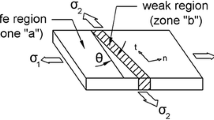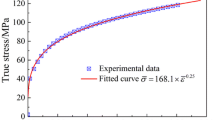Abstract
A free bulge test and ductile fracture criteria were used to obtain the forming limit diagrams (FLD) of aluminum alloy AA6063 tubes at high temperatures. Ductile fracture criteria were calibrated using the results of uniaxial tension tests at various elevated temperatures and different strain rates through adjusting the Zener-Holloman parameter. High temperature free bulge test of tubes was simulated in finite element software Abaqus, and tube bursting was predicted using ductile fracture criteria under different loading paths. FLDs which were obtained from finite element simulation were compared to experimental results to select the most accurate criterion for prediction of forming limit diagram. According to the results, all studied ductile fracture criteria predict similarly when forming condition is close to the uniaxial tension, while Ayada criterion predicts the FLD at 473 K and 573 K very well.
Similar content being viewed by others
References
M. Keigler, H. Bauer, D. Harrison and A. K. M. De Silva, Enhancing the formability of aluminium components via temperature controlled hydroforming, Journal of Materials Processing Technology, 167 (2–3) (2005) 363–370.
S. Yuan and J. Qi, Z. He, An experimental investigation into the formability of hydroforming 5A02 Al-tubes at elevated temperature, Journal of Materials Processing Technology, 177 (1–3) (2006) 680–683.
B. J. Kim, C. J. Van Tyne, M. Y. Lee and Y. H. Moon, Finite element analysis and experimental confirmation of warm hydroforming process for aluminum alloy, Journal of Materials Processing Technology, 187–188 (0) (2007) 296–299.
S. Hashemi, H. Moslemi Naeini, G. Liaghat, R. Azizi Tafti and F. Rahmani, Numerical and experimental investigation of temperature effect on thickness distribution in warm hydroforming of aluminum tubes, Journal of Materials Engineering and Performance, 22 (1) (2013) 57–63.
S. P. Keeler and W. A. Backofen, Plastic instability and fracture in sheets stretched over rigid punches, ASM TRANS Q, 56 (1) (1963) 25–48.
M. Brunet, S. Boumaiza and G. Nefussi, Unified failure analysis for tubular hydroforming, Journal of Materials Processing Technology, 148 (2) (2004) 269–277.
M. Jansson, L. Nilsson and K. Simonsson, On strain localisation in tube hydroforming of aluminium extrusions, Journal of Materials Processing Technology, 195 (1–3) (2008) 3–14.
E. Chu and Y. Xu, Influences of generalized loading parameters on FLD predictions for aluminum tube hydroforming, Journal of Materials Processing Technology, 196 (1–3) (2008) 1–9.
R. Hashemi, A. Assempour and E. M. K. Abad, Implementation of the forming limit stress diagram to obtain suitable load path in tube hydroforming considering M-K model, Materials & Design, 30 (9) (2009) 3545–3553.
Y. M. Hwang, Y. K Lin and H. C. Chuang, Forming limit diagrams of tubular materials by bulge tests, Journal of Materials Processing Technology, 209 (11) (2009) 5024–5034.
J. Kim, W. J. Song and B. S. Kang, Probabilistic modeling of stress-based FLD in tube hydroforming process, J. Mech. Sci. Technol., 23 (11) (2009) 2891–2902.
X. Chen, Z. Yu, B. Hou, S. Li and Z. Lin, A theoretical and experimental study on forming limit diagram for a seamed tube hydroforming, Journal of Materials Processing Technology, 211 (12) (2011) 2012–2021.
A. M. Freudenthal, The inelastic behavior of engineering materials and structures, John Wiley & Sons (1950).
M. Cockcroft and D. Latham, Ductility and the workability of metals, J Inst Metals, 96 (1) (1968) 33–39.
S. Oh, C. Chen and S. Kobayashi, Ductile fracture in axisymmetric extrusion and drawing-Part 2: Workability in extrusion and drawing, Journal of Engineering for Industry, 101 (1979) 36.
P. Brozzo, B. Deluca and R. Rendina, A new method for the prediction of formability limits in metal sheets. In: Proc. 7th biennal Conf. IDDR (1972).
M. Ayada, T. Higashino and K. Mori, Central bursting in extrusion of inhomogeneous materials, Advanced Technology of Plasticity, 1 (1987) 553–558.
J. R. Rice and D. M. Tracey, On the ductile enlargement of voids in triaxial stress fields, Journal of the Mechanics and Physics of Solids, 17 (3) (1969) 201–217.
W. Kim, H. Kim, W. Kim and S. Han, Temperature and strain rate effect incorporated failure criteria for sheet forming of magnesium alloys, Materials Science and Engineering: A, 488 (1) (2008) 468–474.
X. ZHANG, W. ZENG, Y. SHU, Y. ZHOU, Y. ZHAO, H. WU and H. YU, Fracture criterion for predicting surface cracking of Ti40 alloy in hot forming processes, Transactions of Nonferrous Metals Society of China, 19 (2) (2009) 267–271.
H. J. Frost and M. F. Ashby, Deformation mechanism maps: the plasticity and creep of metals and ceramics (1982).
Y. Bao and T. Wierzbicki, On fracture locus in the equivalent strain and stress triaxiality space, International Journal of Mechanical Sciences, 46 (1) (2004) 81–98.
X. Teng and T. Wierzbicki, Evaluation of six fracture models in high velocity perforation, Engineering Fracture Mechanics, 73 (12) (2006) 1653–1678.
I. Barsoum and J. Faleskog, Rupture mechanisms in combined tension and shear-Experiments, International Journal of Solids and Structures, 44 (6) (2007) 1768–1786.
Author information
Authors and Affiliations
Corresponding author
Additional information
Recommended by Associate Editor Dae-Cheol Ko
Seyed Jalal Hashemi is an assistant professor at Kar Higher Education Institute, Qazvin, Iran. His research interests are in tube and sheet hydroforming and deep drawing.
Hassan Moslemi Naeini is a professor at the faculty of Mechanical Engineering, Tarbiat Modares University, Tehran, Iran. His research interests are in roll forming, hydroforming and laser forming.
Gholamhossein Liaghat is a professor at the faculty of Mechanical Engineering, Tarbiat Modares University, Tehran, Iran. His research interests are in plasticity, metal forming and impact mechanics.
Rights and permissions
About this article
Cite this article
Hashemi, S.J., Naeini, H.M., Liaghat, G. et al. Forming limit diagram of aluminum AA6063 tubes at high temperatures by bulge tests. J Mech Sci Technol 28, 4745–4752 (2014). https://doi.org/10.1007/s12206-014-1041-2
Received:
Revised:
Accepted:
Published:
Issue Date:
DOI: https://doi.org/10.1007/s12206-014-1041-2




